
The dwarf dog-faced bat is a species of free-tailed bat from South America. It is found in Argentina, Bolivia, Brazil, Colombia, Ecuador, Guyana, Peru, Paraguay and Uruguay, typically at lower elevations. It is one of two species in the genus Molossops, the other being the rufous dog-faced bat. Three subspecies are often recognized, though mammalogist Judith Eger considers it monotypic with no subspecies. It is a small free-tailed bat, with a forearm length of 28.9–32.5 mm (1.14–1.28 in) and a weight of 5–8 g (0.18–0.28 oz); males are larger than females. It is brown, with paler belly fur and darker back fur. Its wings are unusual for a free-tailed bat, with exceptionally broad wingtips. Additionally, it has low wing loading, meaning that it has a large wing surface area relative to its body weight. Therefore, it flies more similarly to a vesper bat than to other species in its own family. As it forages at night for its insect prey, including moths, beetles, and others, it uses two kinds of frequency-modulated echolocation calls: one type is to navigate in open areas and to search for prey, while the other type is used for navigating in cluttered areas or while approaching a prey item.
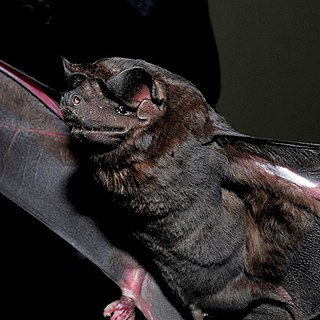
The black mastiff bat is a bat species. It ranges from the northern region of South America, most of Central America and parts of southern Mexico.

Eumops is a genus of bats in the family Molossidae. A total of 17 species of this genus have been described. The name "Eumops" comes from the Greek prefix "Eu-", meaning "good" or "true," and the Malayan word "mops," which means bat.

Peters's wrinkle-lipped bat, also called Peters's goblin bat, is a species of bat in the family Molossidae, the free-tailed bats. It is endemic to Madagascar, where it is widespread and in some areas abundant. It commonly roosts in human-made structures, sometimes in colonies with other free-tailed bat species. It forages in the open, often in agricultural areas. The bat is sexually dimorphic, with males larger than females.

Kalinowski's mastiff bat is a species of bat in the family Molossidae, the free-tailed bats. It is native to Peru and northern Chile. Relatively little is known about the species, but it is thought to be common in its range. It is sometimes seen in urban areas. Molecular sequencing data indicates that the closest relatives of M. kalinowski are members of another genus, Nyctinomops.
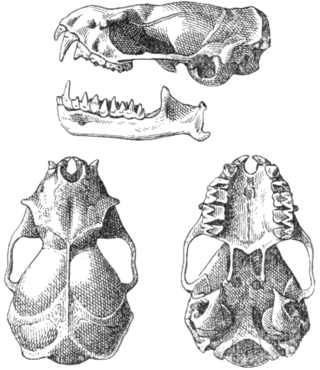
The little goblin bat is a species of bat in the family Molossidae, the free-tailed bats. It is endemic to Cuba.

The São Tomé free-tailed bat is a species of bat in the family Molossidae. It is endemic to São Tomé and Príncipe. Its natural habitats are dry savanna, moist savanna, and plantations. It is threatened by habitat loss. Only three individuals have ever been documented.

The pocketed free-tailed bat is a species of bat in the family Molossidae found in Mexico and in Arizona, California, New Mexico, and Texas in the United States. They resemble the Brazilian free-tailed bat but differ morphologically. They are recognized as "least concern" by the IUCN and as "apparently secure" by Natureserve.

The blunt-eared bat or Peruvian crevice-dwelling bat is a species of bat in the family Molossidae. It is monotypic within the genus Tomopeas and subfamily Tomopeatinae. It is endemic to Peru, where it is considered critically endangered. It is threatened by habitat loss.
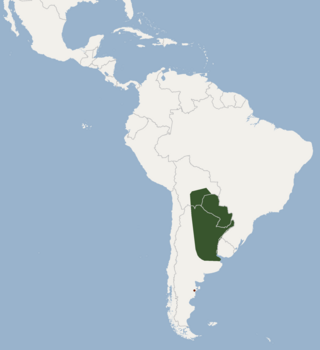
The Patagonian bonneted bat, also called the Patagonian dwarf bonneted bat, is a species of free-tailed bat found in Argentina, Bolivia and Paraguay.

Gallagher's free-tailed bat is a free-tailed bat endemic to the Democratic Republic of the Congo. Only one individual has ever been documented.

The Florida bonneted bat or Florida mastiff bat is a species of bat in the genus Eumops, the bonneted bats or mastiff bats. Until recently, it was classified as a subspecies of Wagner's bonneted bat. It is endemic to southern Florida in the United States. This species has one of the smallest geographical distributions of any New World bat. It has been called "one of the most critically endangered mammal species in North America". It is protected under the Endangered Species Act.
Chaerephon atsinanana is a free-tailed bat found on Madagascar. It was considered a subspecies of the little free-tailed bat until 2010. During the day, they are known to roost in man-made structures such as the roofs or attics of buildings.

Cynomops milleri is a species of bat that is native to South America. It was previously considered a subspecies of the Para dog-faced bat. It is considered a small- to medium-sized member of its genus. It is classified as least concern by the International Union for Conservation of Nature because it appears to be common and widespread. It is found in Venezuela, French Guiana, Guyana, Suriname, Brazil, and Peru.

Harrison's large-eared giant mastiff bat is a species of bat found in Northeast Africa and the Arabian Peninsula. It was described as a new species in 2015. The IUCN evaluates it as a vulnerable species.

Thomas's big-eared brown bat is a species of vesper bat found in South America.
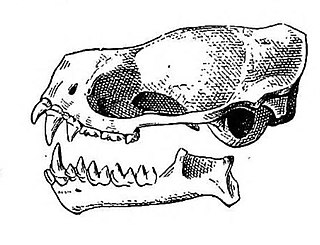
Eumops nanus is a species of bat found in Central and South America.

Eumops ferox, the fierce bonneted bat or the chestnut mastiff bat, is a species of free-tailed bat found in the Caribbean and Mexico. Until recently, it was synonymous with Wagner's bonneted bat.
Eumops wilsoni is a species of bat native to Ecuador and Peru. The bat has a distinct karyotype, sequence of the mitochondrial cytochrome-b gene, and other distinct genetic markers that distinguish it from closely related bats such as Eumops glaucinus and Eumops ferox. However, there are no morphological distinctions from those related species and thus there is uncertainty of its geographic distribution and population status, leading to its classification as "data deficient". Local threats to the bat's dry forest habitat further impede efforts to study the bats. Transition to farmland and urbanization threatens the dry forest habitat of the bat in the Andes. As an endemic species, the bat may be threatened by this habitat loss.
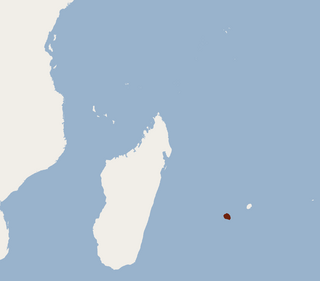
Mormopterus francoismoutoui is a species of free-tailed bat that is endemic to the island of Réunion, which is east of Madagascar.
















